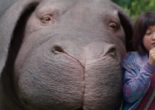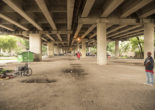Ben Wheatley on “Free Fire”
Ben Wheatley may not be a household name, but to cinema mavens he’s one of the best writer-directors currently making movies. None of Wheatley’s films are the same, yet they all share a love of mixing genre conventions.
Speaking with Wheatley at a press junket for his latest film, Free Fire, last March during SXSW, it’s obvious he’s spent time in the trenches of 1970s cinema, observing and learning. Wheatley, a native of Essex, England, now lives in Brighton with his wife Amy Jump who also co-writes most of his films. The junket was held at Stunt Ranch, located about twenty minutes from downtown Austin.
“I feel like one of those British indie bands. They come over and do one gig and then go home again,” says Wheatley to Free Press Houston, along with other outlets at an outdoor round table.
Wheatley’s previous film High Rise, based on a novel by J. G. Ballard, was set in the ‘70s and depicted the class struggle between the lower and upper floors of a luxury apartment. Wheatley’s other films blur the line between good and bad yet always with a wry comic grin.
For instance, Kill List (2011) starts out like a secret agent film only to become involved with Druid conspiracies. Sightseers (2012) begins innocently enough with a couple that meet cute and decide to go on a road trip. The first day they accidently run over and kill a pedestrian, and before long the couple are driving around landmark sites on a killing spree. A Field in England follows trekking soldiers during civil war in the 17th century and a combination of one-on-one combat situations, alchemy and psychedelic mushrooms transform the players, and the audience, into another realm.
Free Fire is going to make a splash. It’s getting a multi-theater release, not going the way of Wheatley’s previous films that played one week at the Alamo Drafthouse or Sundance Cinemas Houston. The ensemble cast of Free Fire includes Brie Larson, Sharlto Copley, Armie Hammer, Cillian Murphy and Jack Raynor.
During our conversation, Wheatley or maybe one of the reporters present at the round table brought up ’70s/’60s films like Zardoz (1974) and Modesty Blaise (1966). Wheatley is able to drop those films and their meaning into the gist of the conversation.
About the immortals that populate Zardoz, Wheatley quips: “I don’t know about living forever. That’s a tough gig. Why would you want to? There’s this guy, he says if he takes the right selection of pills he can live to 200. I mean why would you want that? I asked him, ‘Why the fuck would you want to do that?’ And he told me so I can talk to my great great grandchildren.
“And I was like, they won’t want to be fucking talking to you,” says Wheatley.
Free Fire depicts a massive shoot-out in a Boston warehouse. A gun deal between arms dealers and the IRA goes wrong. The setting is the 1970s so everyone has wide lapels and flowery clothing. “There was detail to everything, my hair, my facial hair, my clothing,” says Hammer, also at the table.
“We had one training session. We were still inside the warehouse and in a little room off to the side. It was even more full of rumble,” adds Hammer. “Everyone had their character gun and they were like, here we go. ‘You want to fire off a couple of shots?’ Bang, bang, bang, bang, bang. Great. Training over.”
Wheatley used transcripts of a shoot-out as the genesis of the script. “There was a shoot-out in Miami between the FBI and some guys who were going to rob a bank. The FBI had to write down a report shot-for-shot where they were, where the police were, where the bullets were. When I read that I thought, ‘How messy and horrible,’ and how it went on for a long time. People got shot a lot; this was no great epiphany,” says Wheatley. “Everything I’d seen in Hollywood wasn’t like that.
“There has to be a way to show a procedural of a gun battle in real time. I’m not saying that Free Fire is a documentary, but it is using some of that realism.
“There’s no mystery anymore is there?” asks Wheatley referring to why the film is set in a pre-cell phone era. “Nowadays you have teenagers walking past a haunted house and they look at their cell phones and go ‘Five people died there, let’s not go inside,’ or ‘There was a witch in 1520, let’s not go there either,’” says Wheatley.
“There’s a real issue with modern cinema where we really haven’t addressed the whole way of communicating by phone. There’s an American cable show, Ray Donovan. They use the phone a lot in that and it’s not about communication.
“When Amy and I are writing contemporary thrillers we always work out where the flow of information is coming from,” says Wheatley. “It moves between characters.”
Free Fire takes place in a single location. For the most part, the film was shot chronologically. “It’s hard, the issue is if there’s a screw-up at the start you might not know about that until five weeks in, when you find two characters are really too close to each other. There’s a lot of planning that went into it,” says Wheatley. Storyboards were rendered in 3D so Wheatley and cinematographer Laurie Rose could “go inside and walk around the space to make sure it would work. The sets had to be built in a certain way so that all the explosives were wired into the walls. This was all done seven or eight weeks beforehand.”
In a departure from their previous collaborations, Wheatley and Jump would write updates to the script on the set to mirror the relationships that were evolving between the characters.
One reporter asks Wheatley about the cinematic influences going into this film. “Evil Dead 2 and the Warner Brothers cartoons of Tom and Jerry,” replies Wheatley. “In the Raimi movies, there’s the thing where they set up the gags, slapstick gags, and then it pays off. There’re two types of actions cinema. The stuff that comes from Seven Samurai and James Cameron, which is very specific. There’s a cause and effect.
“Or the cinema of Tony Scott or Michael Bay, which is a bit more impressionistic. You have the flags waving in slow motion and shit.
“I also was thinking about the comic book Sgt. Rock. How you always have the platoon and how they make an effort to tell each single person apart. There are individual things, so you know which character is which. In Free Fire it’s similar,” says Wheatley. “Their clothes are very specific to their characters. I have this theory that fashion stops for you when you become 22. You buy your last fashionable clothes and then you wear them constantly for the rest of your life.”
Wheatley ends the interview with an anecdote about watching movies. “Do you know the film Chitty Chitty Bang Bang? So this guy went to see it with his dad. And it has a break in the middle of it, an intermission where you go get some ice cream and come back. But this guy was like ‘that’s the end of the film?’ The break comes just as the car goes off the edge of the cliff, before it flies back up in the next part. So that was the most depressing film they had ever seen.”
Free Fire opens this weekend at area theaters.









